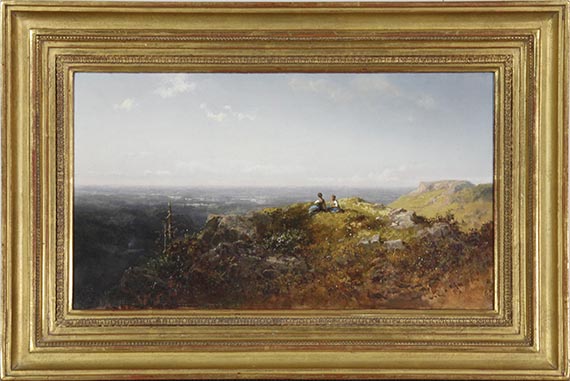364
Carl Spitzweg
Zwei Dirndl auf der Alm, Um 1870.
Oil on canvas
Estimate:
€ 40,000 / $ 46,400 Sold:
€ 53,750 / $ 62,349 (incl. surcharge)
Zwei Dirndl auf der Alm. Um 1870.
Oil on canvas.
Wichmann 1459. Lower left with paraph. Verso of the stretcher with a hand-written number and an exhibiton label from the Haus der Kunst, Munich. 22 x 39 cm (8.6 x 15.3 in).
• Wonderful panorama of the Upper Bavarian Alpine landscape that Spitzweg had been capturing since his artistic beginnings
• Next to the genre paintings, Spitzweg is a master of landscape depictions, which he effectfully modeled with light and shade and transparent aerial perspective
• Spitzweg went on countless hiking trips through the mountains
• The Alpine herdswoman is a characteristic motif for his later creative period when landscape depictions gained importance.
We are grateful to Detlef Rosenberger, who saw the original work, for his kind expert advice.
PROVENANCE: Collection Rolf Schiess, Waldhof, Flawil/Switzerland (no. 224. until 1967).
Private collection Southern Germany (acquired in 1996).
Private collection Germany (acquired in 2011).
EXHIBITION: Carl Spitzweg und die französischen Zeichner Daumier, Grandville, Gavarni, Doré, Haus der Kunst, Munich, November 23 - February 2, 1985, p. 300, no. 535 (with illu. p. 477, verso with th elabel).
LITERATURE: Auktionshaus Neumeister, Munich, auction on March 21, 1996, lot 759 (with illu. on plate 20).
Oil on canvas.
Wichmann 1459. Lower left with paraph. Verso of the stretcher with a hand-written number and an exhibiton label from the Haus der Kunst, Munich. 22 x 39 cm (8.6 x 15.3 in).
• Wonderful panorama of the Upper Bavarian Alpine landscape that Spitzweg had been capturing since his artistic beginnings
• Next to the genre paintings, Spitzweg is a master of landscape depictions, which he effectfully modeled with light and shade and transparent aerial perspective
• Spitzweg went on countless hiking trips through the mountains
• The Alpine herdswoman is a characteristic motif for his later creative period when landscape depictions gained importance.
We are grateful to Detlef Rosenberger, who saw the original work, for his kind expert advice.
PROVENANCE: Collection Rolf Schiess, Waldhof, Flawil/Switzerland (no. 224. until 1967).
Private collection Southern Germany (acquired in 1996).
Private collection Germany (acquired in 2011).
EXHIBITION: Carl Spitzweg und die französischen Zeichner Daumier, Grandville, Gavarni, Doré, Haus der Kunst, Munich, November 23 - February 2, 1985, p. 300, no. 535 (with illu. p. 477, verso with th elabel).
LITERATURE: Auktionshaus Neumeister, Munich, auction on March 21, 1996, lot 759 (with illu. on plate 20).
Carl Spitzweg’s unique characters are world-famous, illustrating tales of fatal, all too human situations and portraying emotional states in bizarre and tragic moments of life. Well-read and widely traveled, Spitzweg drew on his extensive education and wealth of experience. Spending a lot of time exploring, he often visited the lake districts of Upper Bavaria. His paintings relate his encounters with the foothills of the Alps in Chiemgau and his sojourns in South Tyrol, Italy and Switzerland. Spitzweg scaled the mountains and enjoyed the view from the peak, for instance the “monumental” Watzmann in Berchtesgaden in 1836. He also traveled to Paris in the middle of the century, where he was introduced to the latest accomplishments of the Barbizon painters and learned a lot about outdoor, or “plein air” painting and the “paysage intime” style. The latter concentrated on portraying a fragment of a familiar landscape in the open air in natural lighting conditions which were rendered with natural colors. In the following years, Spitzweg increasingly opted for wide, panoramic horizontal views of the open countryside in addition to vertical views of alleys and houses. Beyond the genre he was renowned for, he also saw himself as a great observer of landscapes, which he peopled with small staffage figures – such as the two young girls here – as witnesses and admirers of the unique vistas. The artist went hiking in these unique mountain landscapes, such as the one overlooking the valley in this painting. Having captured the scenery in numerous sketches and small oil studies with narrative accompaniments, he then recreated the vast expanse of the landscapes in the studio. In this painting, Spitzweg recounts the grueling ascent through narrow gorges and across clearings, joining the two maidens in their enjoyment of the panoramic view of the valley from the vantage point of the high pasture below the Herzogstand peak. A sweeping plain opens out towards Landsberg am Lech across the misty Ammersee and Starnberger See lakes. The viewer can feel Spitzweg’s delight in the romantic panorama and his regard for nature’s subtle nuances. He skillfully modulates the refraction of light in its gradual transformation from the evocative, detailed foreground of the mountain pasture and the hazy, sprawling landscape all the way to the horizon, and finally, above it, the vast, cloudless sky. [MvL]
364
Carl Spitzweg
Zwei Dirndl auf der Alm, Um 1870.
Oil on canvas
Estimate:
€ 40,000 / $ 46,400 Sold:
€ 53,750 / $ 62,349 (incl. surcharge)
Headquarters
Joseph-Wild-Str. 18
81829 Munich
Phone: +49 89 55 244-0
Fax: +49 89 55 244-177
info@kettererkunst.de
Louisa von Saucken / Undine Schleifer
Holstenwall 5
20355 Hamburg
Phone: +49 40 37 49 61-0
Fax: +49 40 37 49 61-66
infohamburg@kettererkunst.de
Dr. Simone Wiechers / Nane Schlage
Fasanenstr. 70
10719 Berlin
Phone: +49 30 88 67 53-63
Fax: +49 30 88 67 56-43
infoberlin@kettererkunst.de
Cordula Lichtenberg
Gertrudenstraße 24-28
50667 Cologne
Phone: +49 221 510 908-15
infokoeln@kettererkunst.de
Hessen
Rhineland-Palatinate
Miriam Heß
Phone: +49 62 21 58 80-038
Fax: +49 62 21 58 80-595
infoheidelberg@kettererkunst.de
We will inform you in time.




 Lot 364
Lot 364 
